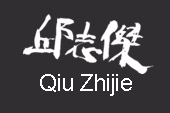 |
Qiu Zhijie- Ethan Cohen Fine Arts |
|||||||
|
, April 17 - May 19, 2001 Qiu Zhijie is by far one of the most prolific and diverse artists that I know. His oeuvre not only includes a myriad of media and forms but also extends to curatorial projects, criticism, and documentary. From the outset Qiu Zhijie1s talents won him notoriety at Zhejiang Academy of Fine Arts, one of China1s most prestigious art academies. As a printmaking major he was one of the first students to present large scale installations as his work. His repertoire quickly expanded to include video works, photography, painting (oil, acrylic, airbrush, ink wash, watercolor), performance, sculpture, CD-ROM work, you name it. Throughout, his work has always maintained a strong conceptual, and often humorist bend. Along with his collaborative partner Wu Meichun, Qiu Zhijie has also organized several large scale video and multi-media exhibitions that been formative in establishing a new media art interest and heritage in China. Now at a very vibrant 32 years old his first NY solo exhibition displays no signs of his interests or production waning. However, given his manifold portfolio, the decision to show much (Chinese) language based work in NY is questionable. Upon first glance the NY show is text. From wall to wall to hanging columns to video monitors to engraved wooden seat mats to tombstones, the viewer is bombarded with Chinese characters. For an artist whose work is never what it seems the text based exhibition1s impact can be potentially lost on a NY audience whose patience and capacity for foreign language is limited. This is further misconstrued by the fact that the exhibition1s venue regularly shows contemporary calligraphy work. Even so, Qiu Zhijie1s bravado does not entirely land on deaf ears. The work stands on its own aesthetically and provides the non-Chinese reader enough clues of its playful and deconstructive nature. Throughout the show Chinese traditional art is manipulated in mischievous ways. This is most explicit in his "Points of Landscape1 series. These 5 large ink paintings categorize different excerpts from Chinese andscape paintings. In one we see the sampling of different architectural structures: houses, gate ways, bridges etc. randomly scattered across the surface. In another we see pagodas, then people, boats, little things (furniture, household objects, etc), everything minus the landscape itself. Here the nuts and bolts of a revered tradition are classified in an almost hardware store style. It is a gesture that seems to mock the seriousness of such a highly pedantic discipline. As if all you had to do was cut and paste from each of the works to produce your very own landscape painting. "Ten Tang Poems " is another work that similarly toys with ancient China1s cultural treasures. Tang Dynasty poetry is a fundamental part of Chinese classical education and hence, cultural identity. On video we see the artist writing from memory ten of the most famous of these classical poems. The results are displayed on the walls around the monitor. This is all very good except that the video is played in reverse so that the artist appears to be erasing the poems. It is a mesmerizing piece that not only reveals the artists1 calligraphic skills (he writes the poems backward to insure a proper up-down sequence) but his metaphysical meandering as well. On a different cultural note, "The West" is a CD-ROM which comically summarizes the cross cultural neptitude that such an exhibition may present; and that recent Sino/US relations have certainly exhibited. This interactive piece presents a series of interviews with Chinese people of different ages and backgrounds about that nebulous region which forms the other half of the world. The CD-ROM discusses the pros and cons of Western thought, culture, mores, social and political policies, Westerners appearance, actions, etc. It is riddled with generalizations and assumptions that Chinese make of Westerners. Though some of the comments may be offensive or laughably untrue it is a completely revealing reflection of how little and much we know about ourselves and about them. "The West", though a strong and certainly fitting piece to show in NY, was over shadowed by the show1s centerpiece. This was a three week long performance in which the artist rubbed together two tombstones (one, American circa 1915 of a two year old girl, and the other A Qing dynasty grave stone) until the nscriptions on both were ground smooth. The grinding occurred in intervals, each spaced by the artist making ink rubbings to document the slowly fading engravings. This forced marriage of paradoxes: death, rebirth, East, West, transience, permanence, was consummated in a pile of dust. Cultural differences and language barriers aside, in the end it is still ashes to ashes and dust to dust. Mathieu Borysevicz, 5.2001 |